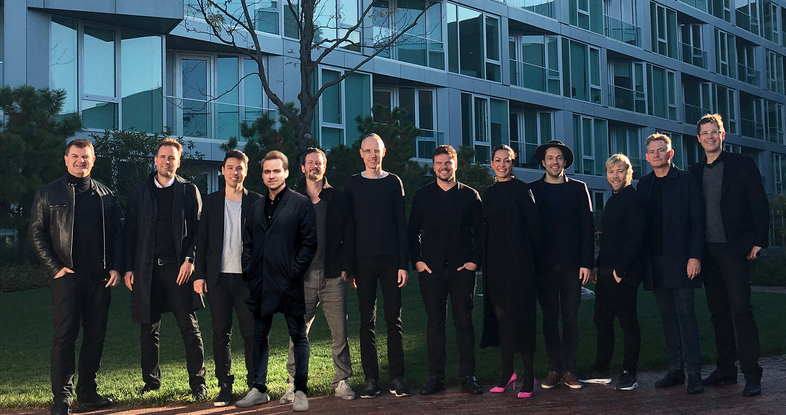Sometime late this year, Bjarke Ingels Group (BIG) expects to move its headquarters into 52,000 sf of space in Brooklyn, N.Y.’s Dumbo neighborhood, which has been dubbed that borough’s Tech Triangle.
BIG’s new location, on the 9th floor of 45 Main Street, will be more than double the 22,000 sf that the firm currently leases in lower Manhattan, where 200-plus employees work in warren-like proximity. If recent history is any guide, BIG is going to need all that extra space, and more, to accommodate its growth plans.
From when Danish architect Bjarke Ingels, at age 30, founded the firm in 2005 through its first 11 years in business, BIG had completed an average of one project annually. Since last fall, the firm—whose leadership team now includes 12 partners—has completed six projects and has seven others under construction. The new normal for BIG is one project per month, says Kai-Uwe Bergmann, Managing Partner and Head of Global Business Development, who has been with the firm virtually from its beginning.
In March, BIG integrated an in-house engineering department, headed by Duncan Horswill, former COO of Søren Jensen Engineers. The next step could be M/E/P engineering.
Another weapon in BIG’s arsenal is BIG IDEAS, the firm’s in-house think tank and specialist research group, which focuses on simulations, product design, and conceptual ideas.
BD+C sat down with the 48-year-old Bergmann, at the firm’s downtown headquarters, on May 2 to discuss how BIG is managing its growth, and what the future bodes.
Driven by a charismatic leader
BIG now has more than 460 architects in its offices in New York, Copenhagen, and London. It entered the U.S. six years ago to work on what has become one of its signature projects: VIA 57 West, the sail-shaped residential building along New York City’s Hudson River.

Bjarke Ingels Group expanded into the U.S. six years ago at the behest of developer Durst Organization, for which the Danish firm designed VIA 57 West, the 32-story, 709-unit residential tower along New York's Hudson River. Image: Iwan Baan, Courtesy of BIG
BIG has designed projects in over 25 countries, and currently has ongoing construction in 12 of them. BIG generates about 60% to 70% of its work from direct commissions, which is in stark contrast to its beginnings, when the fledgling firm bid on as many projects as it could possibly be considered.
Despite its upward and onward trajectory, BIG isn’t currently planning to open more offices, as Bergmann says existing offices can still be developed and consolidated.
In a relatively short time span, Ingels, now 42, and his partners have built BIG into one of the industry’s dynamos.
While the firm’s success has been a collective effort, the press can’t get enough of Ingels, who genuinely seems to relish his role as a celebrity architect and the very public face of his eponymous company.
Articulate, intelligent, boyishly handsome, supremely confident in his talent, and opinionated—he once scoffed at most architecture as having “zero innovation”—Ingels’ star has continued to rise, and the accolades keep pouring in: last year, Time magazine anointed him one of the world’s most influential people, and he was the recipient of the Louis Kahn Memorial Award.
But Ingels is also aware of the hazards of publicity: in a recent freewheeling profile in Rolling Stone magazine, he expressed concern that a segment about BIG on “60 Minutes” made him look like a “salesman.”
A recent health scare also gave Ingels pause to see life beyond his reflection. A just-released documentary on the company, “BIG Time,” shows a listless and distracted Ingels during staff meetings. One possible cause, the film suggests, was a small cyst on the right side of Ingels’ brain that a November 2013 MRI detected. While the results from a CT scan last August were negative, the ordeal at the very least disabused Ingels of any intimations of immortality.
Despite his indefatigable pace and commitments, Ingels remains involved in every project, and Bergmann portrays him as “the conductor of a symphony.” BIG’s partners all have a vote in the business’ strategy and direction. During travel-heavy periods, and with construction sites all around the globe, management and project teams stay in touch about projects and other matters via weekly PDFs to make sure everyone’s on the same page.
Each Partner manages different projects and has a specific area of expertise. At the conceptual stage, project teams consist of four to six people, and then teams get ramped up depending on a job’s complexity and schedule. Bergmann says all project team members are present at client meetings and work sessions, where “ideas come from everyone.”
BIG’s reputation has been its willingness to take on esoteric projects and bring them in on time and within budget. “We seek to combine pragmatic solutions with utopian visions, and spend as much time [selecting] materials as we do with design,” says Bergmann.
Among its recent major commissions are new headquarters for San Pellegrino in Italy and Google in northern California. Bergmann says Google’s massive North Bay campus project—for which new designs were just made public—is a “demanding but inspiring” challenge. “We are taking space planning to another level.” This project is also the first on which BIG has worked with robotics. (Bergmann is on record stating that robotics will eventually transform construction practices.)
He envies Silicon Valley’s adventurous culture, and that tech firms don’t get criticized to the degree that architectural firms do when experiments don’t pan out.
That being said, BIG is set on expanding the role of the architectural firm.
For example, BIG has attached Peter Madsen, the founder of RML Spacelab and an amateur rocket builder, to its Copenhill/Amager Bakke waste incineration plant project in Copenhagen, whose 406-foot chimney will emit a smoke ring every time a ton of CO2 is released into the atmosphere, to remind local residents of their carbon footprint. This facility, slated to open in 2018, will include a functioning 1,300-ft-long ski slope, and the plant’s façade will be covered in foliage.
BIG is providing design ideas for Hyperloop One, a Los Angeles-based company that has been developing systems that, if realized, would transport passengers and freight in pods through pressurized tubes at 600 miles per hour.
This project might seem more than a tad outside of BIG’s area of proficiency. But, explains Bergmann, “if we leave everything to traffic engineers, we’re only going to have a lot of clover leafs.”
Even more ambitious is BIG’s involvement, with several other firms, in the Big U, a sustainable system that would protect New York’s Lower Manhattan from floodwater, storms, and other impacts of a changing climate. The project is conceived as 10 continuous miles of protection tailored to respond to neighborhoods and community-desired amenities.Bergmann says the first 2.5 miles of this project—which the press refers to as The DryLine—on Lower Manhattan’s East Side is already funded and will start construction next year. The next 3.5-mile stretch is in design.
HUD and New York City are financing the Big U. And Bergmann expects mayors—who can see the threat that climate change poses to their cities and residents first hand—to spearhead future sustainable projects of this magnitude.
Kai-Uwe Bergmann sees his role as a mentor expanding as BIG expands its services and portfolio. Image: BD+C
Reaching out
BIG “wants to engage a broader audience,” says Bergmann, and to move architecture and design beyond being primarily technical disciplines to being part of the larger public conversation about the built environment.
To that end, the firm, in recent profiles about the firm that included an episode on Netflix’s “Abstract” series on art, pulled back the curtains to provide a behind-the-scenes look at how BIG’s cutting-edge designs make buildings a reality.
The firm wants to work on more projects “where live, work, and play intersect,” says Bergmann. He points specifically to a student housing project in Denmark, built with containers, that was one-fifth the cost and one-third the construction time compared to conventional building practices.
As BIG’s portfolio has expanded, so, too, has Bergmann’s. He teaches at the University of Pennsylvania, and is a much-sought-after speaker and competition juror. He sits on the board of the Van Alen Institute, through which he and other architects visit different cities every six months. And, he recently got married.
Bergmann sees his role at BIG evolving to include more mentoring. He would also like to do more work “on an urban scale,” such as the master plan for the city of Pittsburgh, which his team completed last year.
As for BIG, Bergmann sees room for improvement. “If you think of us as an organism, we’re still in our tweenies period.” But he also hopes the firm never loses the optimism that’s gotten it this far.
Related Stories
Windows and Doors | Feb 28, 2024
DOE launches $2 million prize to advance cost-effective, energy-efficient commercial windows
The U.S. Department of Energy launched the American-Made Building Envelope Innovation Prize—Secondary Glazing Systems. The program will offer up to $2 million to encourage production of high-performance, cost-effective commercial windows.
AEC Innovators | Feb 28, 2024
How Suffolk Construction identifies ConTech and PropTech startups for investment, adoption
Contractor giant Suffolk Construction has invested in 27 ConTech and PropTech companies since 2019 through its Suffolk Technologies venture capital firm. Parker Mundt, Suffolk Technologies’ Vice President–Platforms, recently spoke with Building Design+Construction about his company’s investment strategy.
Performing Arts Centers | Feb 27, 2024
Frank Gehry-designed expansion of the Colburn School performing arts center set to break ground
In April, the Colburn School, an institute for music and dance education and performance, will break ground on a 100,000-sf expansion designed by architect Frank Gehry. Located in downtown Los Angeles, the performing arts center will join the neighboring Walt Disney Concert Hall and The Grand by Gehry, forming the largest concentration of Gehry-designed buildings in the world.
Construction Costs | Feb 27, 2024
Experts see construction material prices stabilizing in 2024
Gordian’s Q1 2024 Quarterly Construction Cost Insights Report brings good news: Although there are some materials whose prices have continued to show volatility, costs at a macro level are returning to a level of stability, suggesting predictable historical price escalation factors.
High-rise Construction | Feb 23, 2024
Designing a new frontier in Seattle’s urban core
Graphite Design Group shares the design for Frontier, a 540,000-sf tower in a five-block master plan for Seattle-based tech leader Amazon.
Construction Costs | Feb 22, 2024
K-12 school construction costs for 2024
Data from Gordian breaks down the average cost per square foot for four different types of K-12 school buildings (elementary schools, junior high schools, high schools, and vocational schools) across 10 U.S. cities.
MFPRO+ Special Reports | Feb 22, 2024
Crystal Lagoons: A deep dive into real estate's most extreme guest amenity
These year-round, manmade, crystal clear blue lagoons offer a groundbreaking technology with immense potential to redefine the concept of water amenities. However, navigating regulatory challenges and ensuring long-term sustainability are crucial to success with Crystal Lagoons.
Architects | Feb 21, 2024
Architecture Billings Index remains in 'declining billings' state in January 2024
Architecture firm billings remained soft entering into 2024, with an AIA/Deltek Architecture Billings Index (ABI) score of 46.2 in January. Any score below 50.0 indicates decreasing business conditions.
University Buildings | Feb 21, 2024
University design to help meet the demand for health professionals
Virginia Commonwealth University is a Page client, and the Dean of the College of Health Professions took time to talk about a pressing healthcare industry need that schools—and architects—can help address.
AEC Tech | Feb 20, 2024
AI for construction: What kind of tool can artificial intelligence become for AEC teams?
Avoiding the hype and gathering good data are half the battle toward making artificial intelligence tools useful for performing design, operational, and jobsite tasks.

















